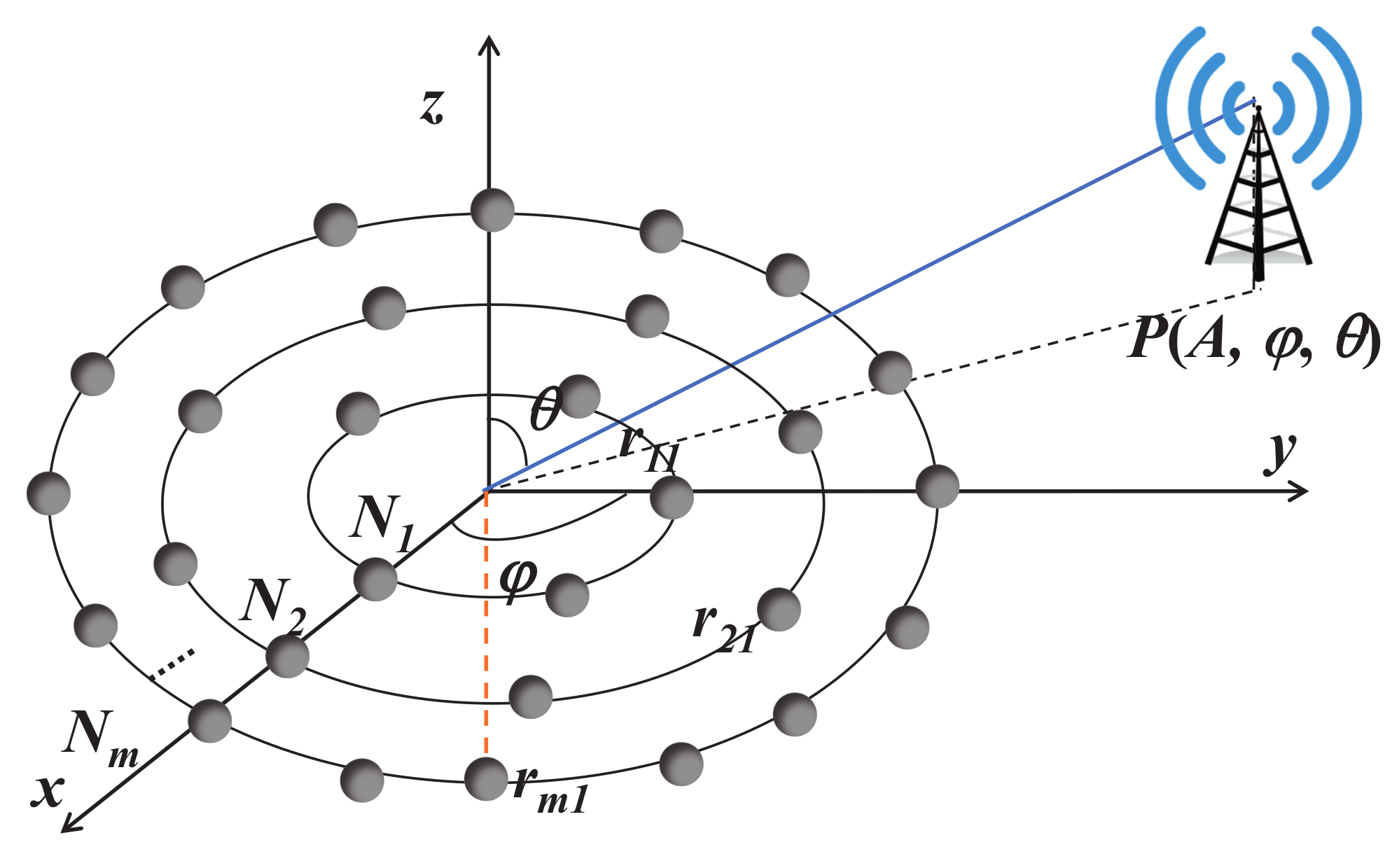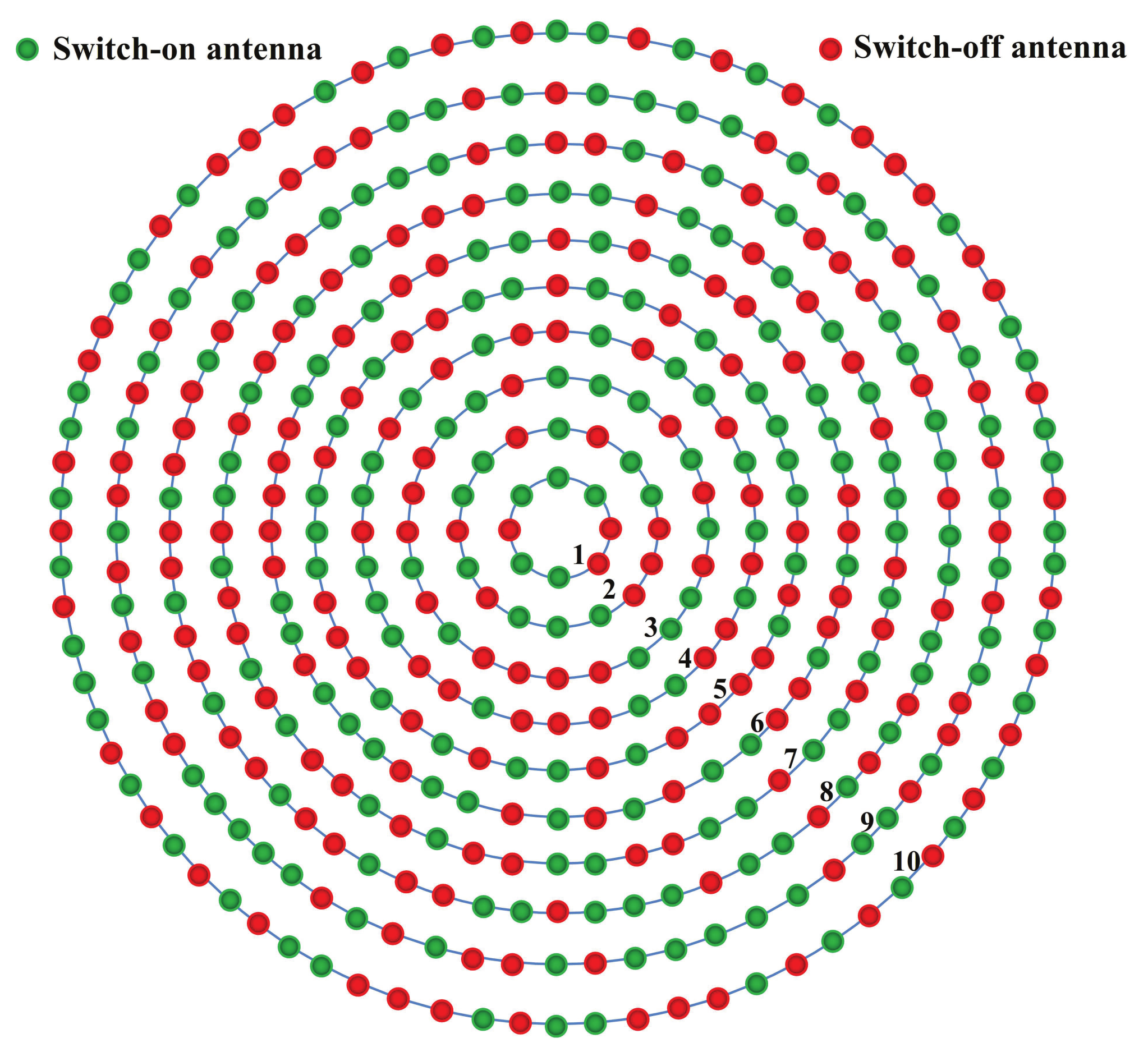Evolutionary Computation for Sparse Synthesis Optimization of CCAAs: An Enhanced Whale Optimization Algorithm Method
Abstract
:1. Introduction
- We formulate a novel optimization problem to turn off a specific number of antennas while reducing the sidelobes of CCAAs. The problem is challenging because it involves both binary and continuous decision variables and is an NP-hard problem.
- We propose an enhanced whale optimization algorithm (EWOA) to solve our formulated problem. EWOA introduces chaos theory and thereby proposes a novel hybrid solution initialization method. Moreover, we propose a hybrid solution crossover approach to balance the exploitation and exploration abilities of the EWOA. Finally, we propose a hybrid solution update method to handle the specific structure of the problem. After being enhanced, the proposed EWOA is more suitable and efficient in solving our considered problem and has a main difference from the conventional EWOA.
- We conduct extensive simulations to verify the performance of the proposed EWOA. The simulation results show that the proposed EWOA is effective and outperforms other peer algorithms. Moreover, the proposed improved factors are also evaluated and demonstrated.
2. Related Works
2.1. Deterministic Methods
2.2. Evolutionary Computation Approaches
3. Model and Problem
3.1. CCAA Models
3.2. Inactivated or Activated Antenna Model
3.3. Sidelobe Suppression Model
3.4. Optimization Problem
4. Proposed Algorithm
4.1. Overview of Evolutionary Computation
4.2. Conventional Whale Optimization Algorithm
4.2.1. Encircling Prey
4.2.2. Bubble-Net Attacking Method
- (i)
- Shrinking encircling mechanism. This behavior is achieved by reducing the value of parameter a, and the details can be found in [24].
- (ii)
- Spiral updating position. WOA uses a helix-shaped movement of humpback whales to guide the update of the population, which can be shown as follows.
4.2.3. Search for Prey
4.2.4. Shortcomings
4.3. Proposed Enhanced Algorithm
4.3.1. Hybrid Solution Initialization Method
4.3.2. Hybrid Solution Crossover
| Algorithm 1: Hybrid Solution Crossover. |
 |
4.3.3. Hybrid Solution Update
| Algorithm 2: Hybrid Solution Update. |
 |
4.3.4. Main Steps and Complexity Analysis of EWOA
| Algorithm 3: EWOA. |
 |
5. Simulations
5.1. Setups
5.2. Simulation Results
6. Conclusions
Author Contributions
Funding
Institutional Review Board Statement
Informed Consent Statement
Data Availability Statement
Conflicts of Interest
References
- Kala, D.D.; Sundari, D.T. A review on optimization of antenna array by evolutionary optimization techniques. Int. J. Intell. Unmanned Syst. 2021.
- Geyi, W. The method of maximum power transmission efficiency for the design of antenna arrays. IEEE Open J. Antennas Propag. 2021, 2, 412–430. [Google Scholar] [CrossRef]
- Ioannides, P.; Balanis, C.A. Uniform circular and rectangular arrays for adaptive beamforming applications. IEEE Antennas Wirel. Propag. Lett. 2005, 4, 351–354. [Google Scholar] [CrossRef]
- Dutta, K.P.; Mahanti, G.K. Evolutionary algorithms for optimal synthesis of thinned multiple concentric circular array antenna with constraints. Int. J. Electron. 2020, 107, 1649–1662. [Google Scholar] [CrossRef]
- Dessouky, M.I.; Sharshar, H.; Albagory, Y. Efficient sidelobe reduction technique for small-sized concentric circular arrays. Prog. Electromagn. Res. 2006, 65, 187–200. [Google Scholar] [CrossRef] [Green Version]
- Sun, G.; Liu, Y.; Chen, Z.; Liang, S.; Wang, A.; Zhang, Y. Radiation beam pattern synthesis of concentric circular antenna arrays using hybrid approach based on cuckoo search. IEEE Trans. Antennas Propag. 2018, 66, 4563–4576. [Google Scholar] [CrossRef]
- Das, A.; Mandal, D.; Ghoshal, S.; Kar, R. Concentric circular antenna array synthesis for side lobe suppression using moth flame optimization. AEU-Int. J. Electron. Commun. 2018, 86, 177–184. [Google Scholar] [CrossRef]
- Dutta, K.P.; Mahanti, G.K. Synthesizing uniform concentric circular array antenna for minimized sidelobes using teaching–learning-based optimization algorithm. In Emerging Technologies in Data Mining and Information Security; Springer: Berlin/Heidelberg, Germany, 2021; pp. 243–251. [Google Scholar]
- Sun, G.; Liu, Y.; Chen, Z.; Zhang, Y.; Wang, A.; Liang, S. Thinning of concentric circular antenna arrays using improved discrete cuckoo search algorithm. In Proceedings of the 2017 IEEE Wireless Communications and Networking Conference (WCNC), San Francisco, CA, USA, 19–22 March 2017; pp. 1–6. [Google Scholar]
- Buttazzoni, G.; Babich, F.; Vatta, F.; Comisso, M. Geometrical synthesis of sparse antenna arrays using compressive sensing for 5G IoT applications. Sensors 2020, 20, 350. [Google Scholar] [CrossRef] [Green Version]
- Morabito, A.F.; Nicolaci, P.G. Optimal synthesis of shaped beams through concentric ring isophoric sparse arrays. IEEE Antennas Wirel. Propag. Lett. 2016, 16, 979–982. [Google Scholar] [CrossRef]
- Fan, W.; Liang, J.; Fan, X.; So, H.C. A unified sparse array design framework for beampattern synthesis. Signal Process. 2021, 182, 107930. [Google Scholar] [CrossRef]
- Pinchera, D.; Migliore, M.D.; Schettino, F.; Lucido, M.; Panariello, G. An effective compressed-sensing inspired deterministic algorithm for sparse array synthesis. IEEE Trans. Antennas Propag. 2017, 66, 149–159. [Google Scholar] [CrossRef]
- Caratelli, D.; Vigano, M.C. A novel deterministic synthesis technique for constrained sparse array design problems. IEEE Trans. Antennas Propag. 2011, 59, 4085–4093. [Google Scholar] [CrossRef]
- Comisso, M.; Palese, G.; Babich, F.; Vatta, F.; Buttazzoni, G. 3D multi-beam and null synthesis by phase-only control for 5G antenna arrays. Electronics 2019, 8, 656. [Google Scholar] [CrossRef] [Green Version]
- Dutta, K.P.; Sundi, S.; Khalkho, S.S.; Tirkey, J.; Hembrom, K.K. Minimization of sidelobe level of uniformly excited concentric circular array antenna using evolutionary technique. In Innovative Data Communication Technologies and Application; Springer: Berlin/Heidelberg, Germany, 2021; pp. 185–194. [Google Scholar]
- Ismaiel, A.M.; Elsaidy, E.; Albagory, Y.; Atallah, H.A.; Abdel-Rahman, A.B.; Sallam, T. Performance improvement of high altitude platform using concentric circular antenna array based on particle swarm optimization. AEU-Int. J. Electron. Commun. 2018, 91, 85–90. [Google Scholar] [CrossRef]
- Taser, A.E.; Guney, K.; Kurt, E. Synthesizing of concentric circular antenna arrays by using a combination of ant lion optimizer and sequential quadratic programming. Int. J. Numer. Model. Electron. Netw. Devices Fields 2022, e3071. [Google Scholar] [CrossRef]
- Challa Ram, G.; Girish Kumar, D.; Venkata Subbarao, M. A Novel Optimization for Synthesis of Concentric Circular Array Antenna. In Intelligent Data Engineering and Analytics; Springer: Berlin/Heidelberg, Germany, 2022; pp. 343–349. [Google Scholar]
- Durmus, A.; Kurban, R. Optimal synthesis of concentric circular antenna arrays using political optimizer. IETE J. Res. 2022, 68, 768–777. [Google Scholar] [CrossRef]
- Li, J.; Kang, H.; Sun, G.; Liang, S.; Liu, Y.; Zhang, Y. Physical Layer Secure Communications Based on Collaborative Beamforming for UAV Networks: A Multi-objective Optimization Approach. In Proceedings of the IEEE INFOCOM 2021-IEEE Conference on Computer Communications, Vancouver, BC, Canada, 10–13 May 2021; pp. 1–10. [Google Scholar]
- Balanis, C.A. Antenna Theory: Analysis and Design; John Wiley & Sons: Hoboken, NJ, USA, 2015. [Google Scholar]
- Parpinelli, R.S.; Plichoski, G.F.; Silva, R.S.D.; Narloch, P.H. A review of techniques for online control of parameters in swarm intelligence and evolutionary computation algorithms. Int. J. -Bio-Inspired Comput. 2019, 13, 1–20. [Google Scholar] [CrossRef]
- Mirjalili, S.; Lewis, A. The whale optimization algorithm. Adv. Eng. Softw. 2016, 95, 51–67. [Google Scholar] [CrossRef]
- Mirjalili, S. Dragonfly algorithm: A new meta-heuristic optimization technique for solving single-objective, discrete, and multi-objective problems. Neural Comput. Appl. 2016, 27, 1053–1073. [Google Scholar] [CrossRef]
- Nadimi-Shahraki, M.H.; Taghian, S.; Mirjalili, S. An improved grey wolf optimizer for solving engineering problems. Expert Syst. Appl. 2021, 166, 113917. [Google Scholar] [CrossRef]
- Mirjalili, S.M.; Mirjalili, S.Z.; Saremi, S.; Mirjalili, S. Sine cosine algorithm: Theory, literature review, and application in designing bend photonic crystal waveguides. Nat.-Inspired Optim. 2020, 811, 201–217. [Google Scholar]
- Faris, H.; Mirjalili, S.; Aljarah, I.; Mafarja, M.; Heidari, A.A. Salp swarm algorithm: Theory, literature review, and application in extreme learning machines. Nat.-Inspired Optim. 2020, 811, 185–199. [Google Scholar]





| (DB) | AVE. | MAX. | MIN. |
|---|---|---|---|
| DA | −23.2598 | −22.6900 | −23.7409 |
| GWO | −23.2644 | −22.6404 | −24.0011 |
| SSA | −23.2434 | −22.6982 | −23.8245 |
| WOA | −23.441 | −22.8497 | −24.0907 |
| SCA | −21.2753 | −20.1031 | −22.3683 |
| EWOA | −23.7883 | −23.2147 | −24.1995 |
| (DB) | AVE. | MAX. | MIN. |
|---|---|---|---|
| DA | 409.3217 | 520.8348 | 286.9482 |
| GWO | 271.8296 | 298.7387 | 232.12 |
| SSA | 273.4268 | 302.3688 | 222.1255 |
| WOA | 297.5742 | 312.5098 | 290.1445 |
| SCA | 254.5393 | 290.0058 | 189.7762 |
| EWOA | 313.075 | 250.7853 | 331.1821 |
| (DB) | AVE. | MAX. | MIN. |
|---|---|---|---|
| Chebyshev | −23.5074 | −23.0789 | −23.934 |
| Circle | −23.4647 | −23.0118 | −23.8412 |
| Guass/mouse | −23.4788 | −22.9087 | −24.0222 |
| Iterative | −23.5758 | −23.0417 | −23.9682 |
| Logistic | −23.4941 | −22.5767 | −23.9068 |
| Piecewise | −23.4257 | −22.7275 | −23.8546 |
| Sine | −23.4498 | −22.8004 | −24.0941 |
| Singer | −23.4784 | −22.9801 | −23.9801 |
| Sinusoidal | −23.508 | −23.0097 | −23.9226 |
| Tent | −23.4395 | −23.0049 | −23.9017 |
| Crossover | −23.7153 | −23.1617 | −24.2604 |
| EWOA | −23.7883 | −23.2147 | −24.1995 |
| (s) | AVE. | MAX. | MIN. |
|---|---|---|---|
| Chebyshev | 300.2103 | 311.8449 | 273.2599 |
| Circle | 300.4639 | 308.2679 | 264.3575 |
| Guass/mouse | 305.5025 | 321.2203 | 285.5261 |
| Iterative | 311.7976 | 337.1776 | 182.6852 |
| Logistic | 306.6116 | 323.0361 | 290.9548 |
| Piecewise | 306.8332 | 328.9165 | 279.5588 |
| Sine | 331.7841 | 340.0234 | 322.1776 |
| Singer | 333.9409 | 341.0207 | 314.4988 |
| Sinusoidal | 337.2349 | 350.9823 | 277.0756 |
| Tent | 336.8633 | 354.8735 | 274.9848 |
| Crossover | 302.2373 | 316.8397 | 243.6888 |
| EWOA | 313.075 | 331.1821 | 250.7853 |
| (DB) | AVE. | MAX. | MIN. |
|---|---|---|---|
| DA | −22.492 | −21.281 | −23.5388 |
| GWO | −22.7027 | −21.8035 | −23.5196 |
| SSA | −22.7403 | −22.0197 | −23.8178 |
| WOA | −22.7205 | −21.647 | −23.4629 |
| SCA | −20.1068 | −18.9223 | −22.2253 |
| EWOA | −23.0437 | −22.5879 | −23.6858 |
| (DB) | AVE. | MAX. | MIN. |
|---|---|---|---|
| DA | −8.73719 | −8.39645 | −9.46009 |
| GWO | −9.05977 | −8.16812 | −9.57519 |
| SSA | −8.99624 | −8.71156 | −9.36257 |
| WOA | −9.09705 | −8.32748 | −9.47902 |
| SCA | −8.91788 | −8.3524 | −9.36407 |
| EWOA | −9.41423 | −9.15111 | −9.6363 |
| (DB) | AVE. | MAX. | MIN. |
|---|---|---|---|
| DA | −8.27269 | −7.7332 | −9.08744 |
| GWO | −8.68996 | −7.24128 | −9.26944 |
| SSA | −8.59402 | −7.72822 | −9.31861 |
| WOA | −8.67264 | −7.46379 | −9.38475 |
| SCA | −8.56307 | −7.73576 | −9.14937 |
| EWOA | −9.1513 | −8.67405 | −9.45595 |
Publisher’s Note: MDPI stays neutral with regard to jurisdictional claims in published maps and institutional affiliations. |
© 2022 by the authors. Licensee MDPI, Basel, Switzerland. This article is an open access article distributed under the terms and conditions of the Creative Commons Attribution (CC BY) license (https://creativecommons.org/licenses/by/4.0/).
Share and Cite
Tang, B.; Cai, L.; Yang, S.; Xu, J.; Yu, Y. Evolutionary Computation for Sparse Synthesis Optimization of CCAAs: An Enhanced Whale Optimization Algorithm Method. Future Internet 2022, 14, 347. https://doi.org/10.3390/fi14120347
Tang B, Cai L, Yang S, Xu J, Yu Y. Evolutionary Computation for Sparse Synthesis Optimization of CCAAs: An Enhanced Whale Optimization Algorithm Method. Future Internet. 2022; 14(12):347. https://doi.org/10.3390/fi14120347
Chicago/Turabian StyleTang, Bohao, Lihua Cai, Shuai Yang, Jiaxing Xu, and Yi Yu. 2022. "Evolutionary Computation for Sparse Synthesis Optimization of CCAAs: An Enhanced Whale Optimization Algorithm Method" Future Internet 14, no. 12: 347. https://doi.org/10.3390/fi14120347
APA StyleTang, B., Cai, L., Yang, S., Xu, J., & Yu, Y. (2022). Evolutionary Computation for Sparse Synthesis Optimization of CCAAs: An Enhanced Whale Optimization Algorithm Method. Future Internet, 14(12), 347. https://doi.org/10.3390/fi14120347








